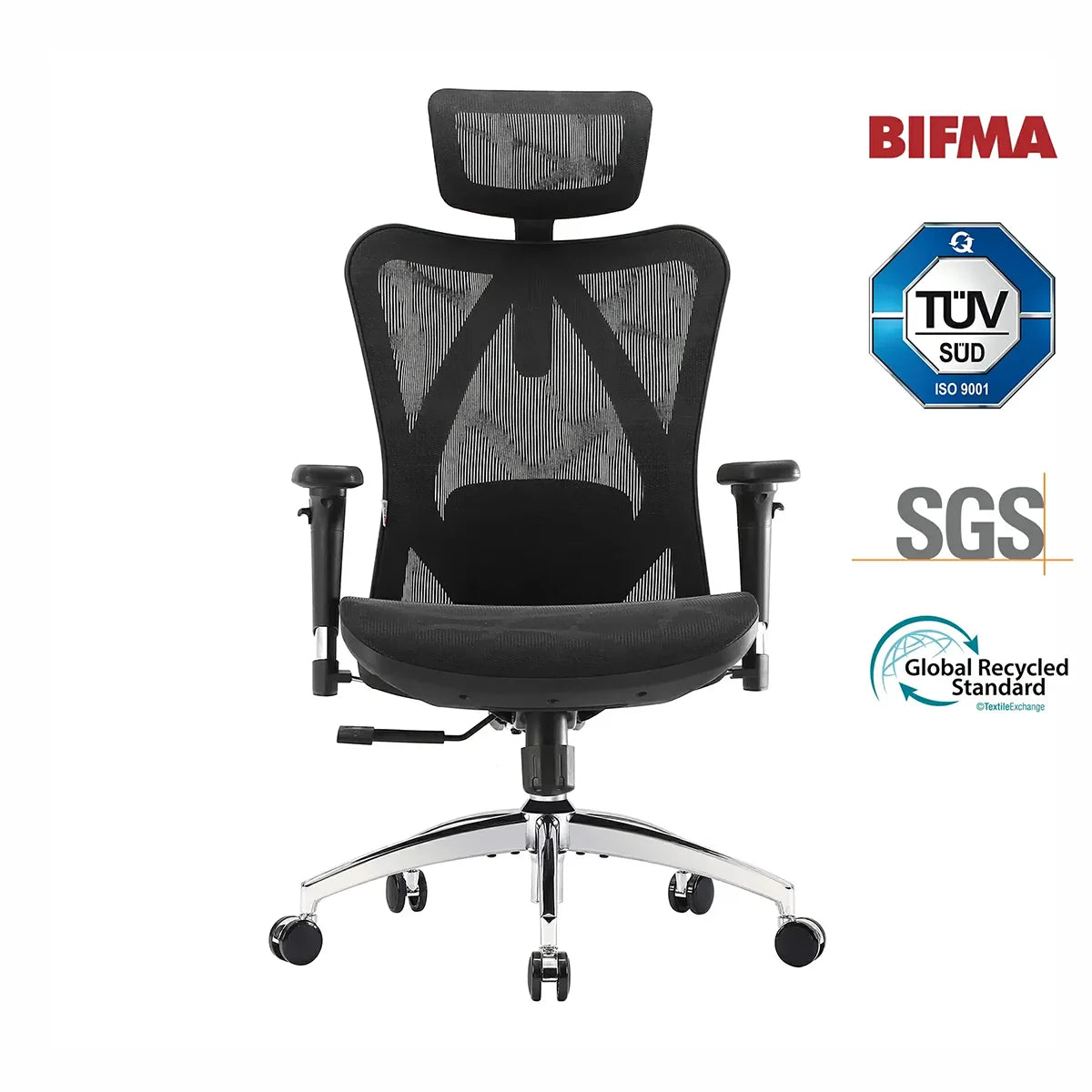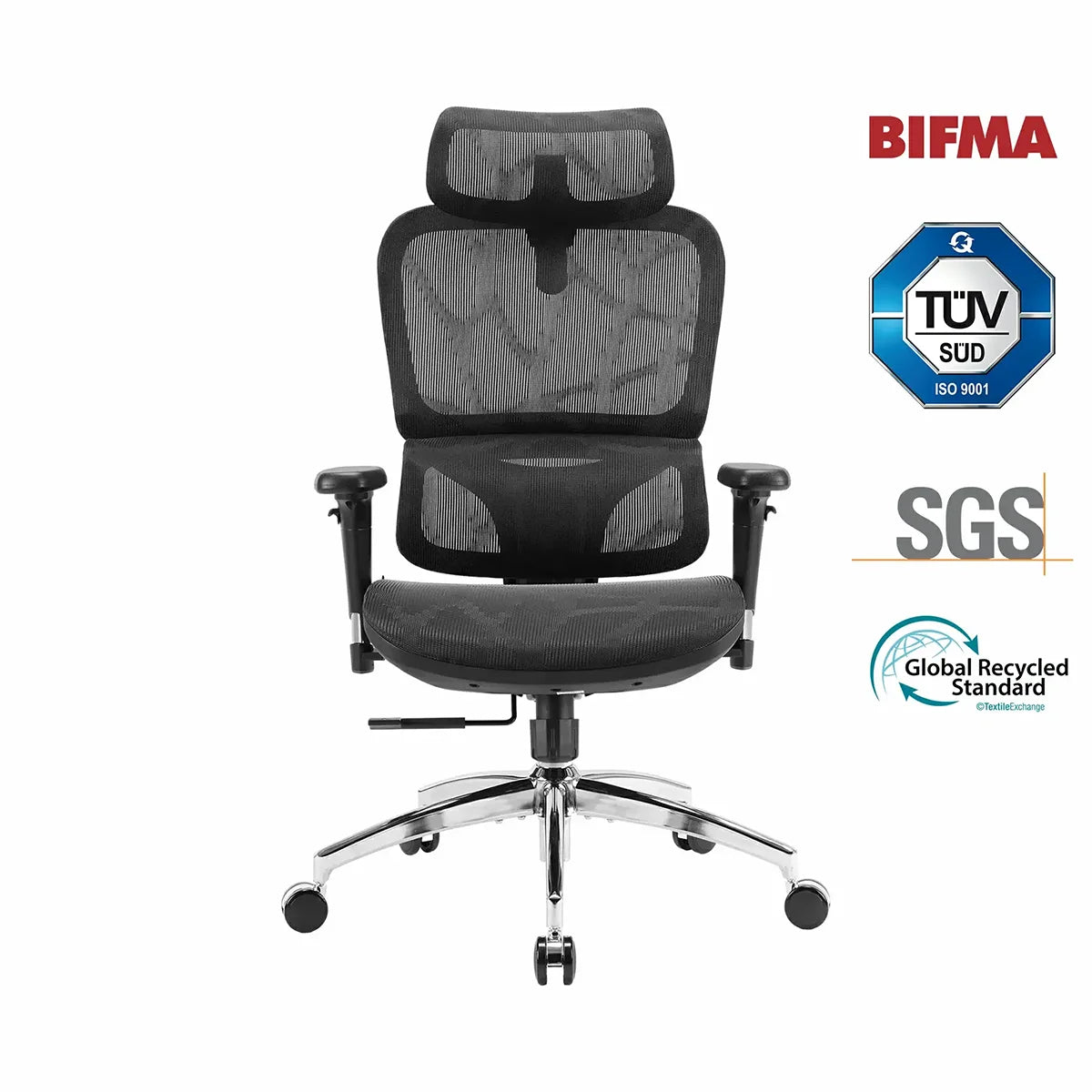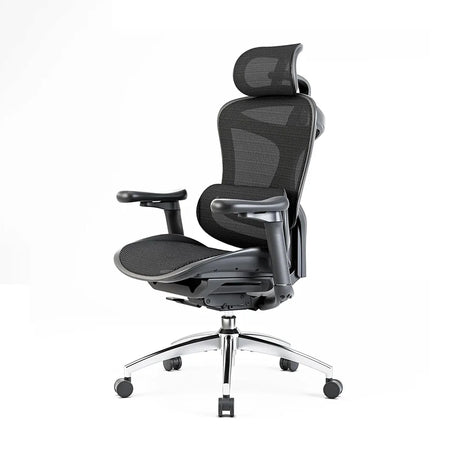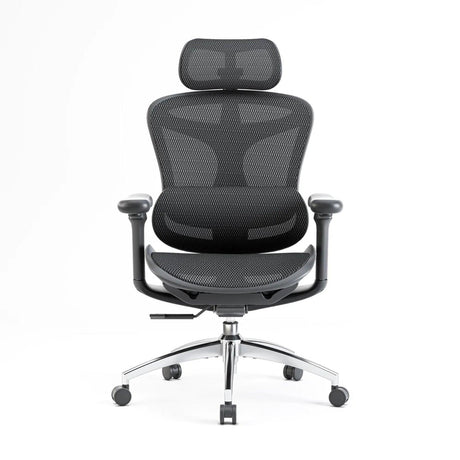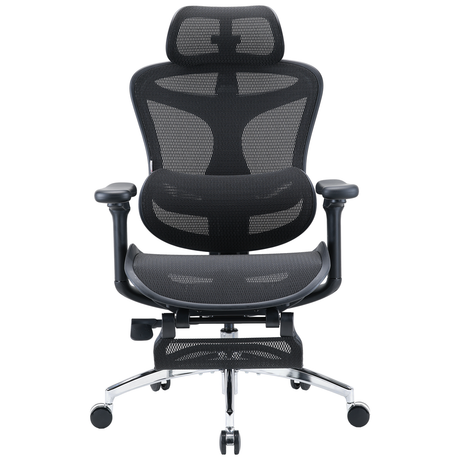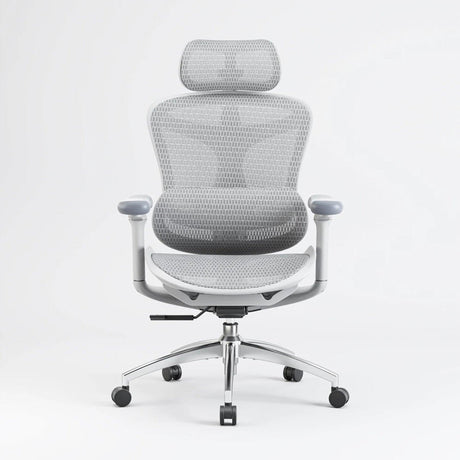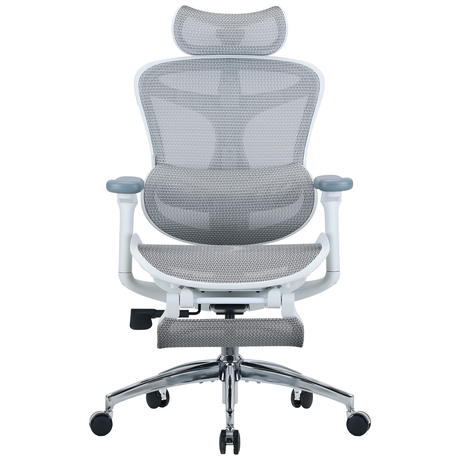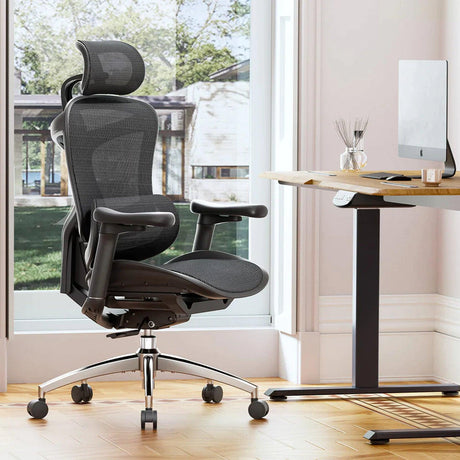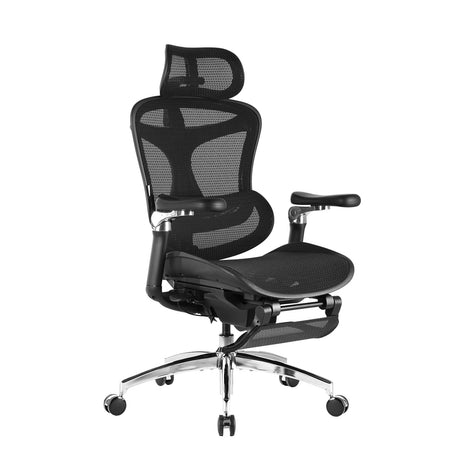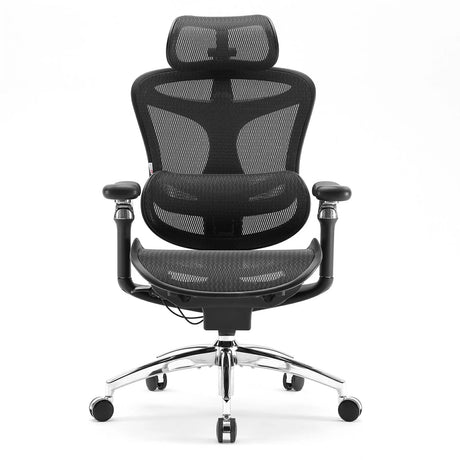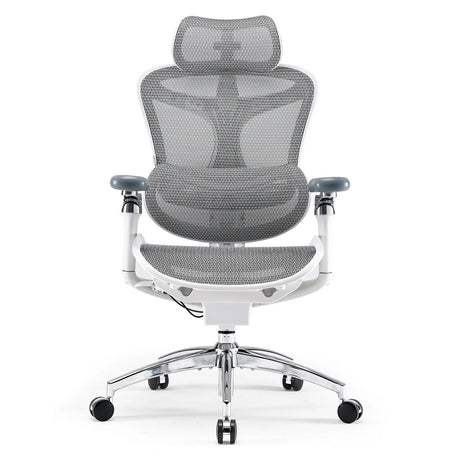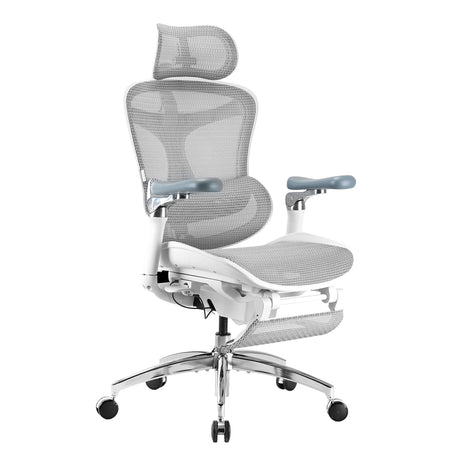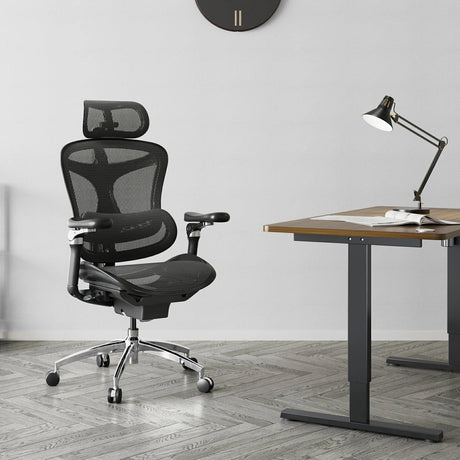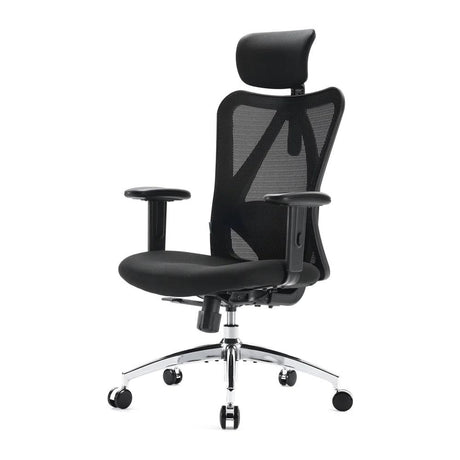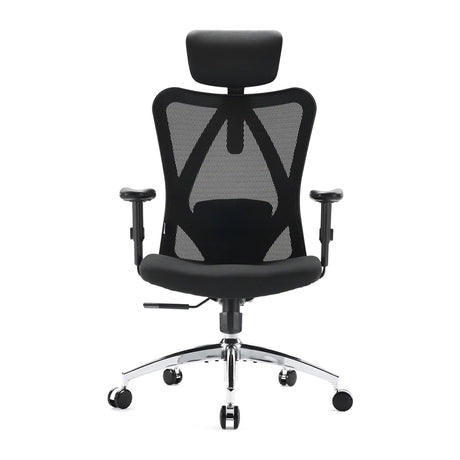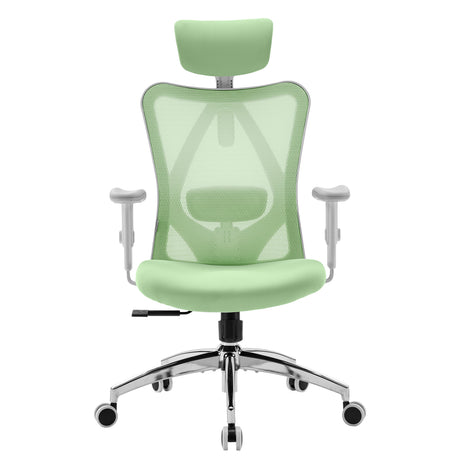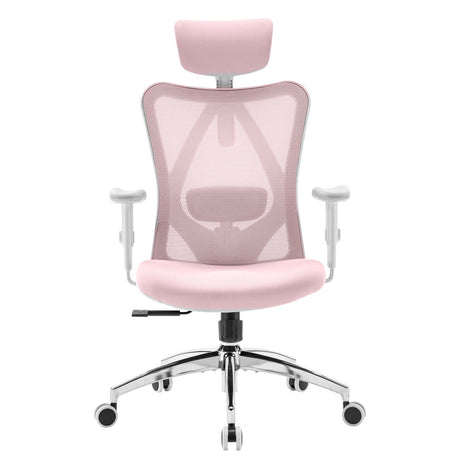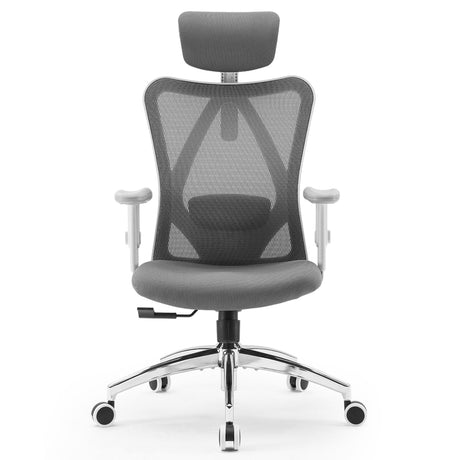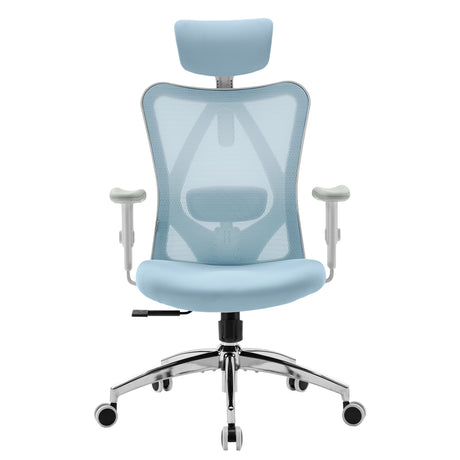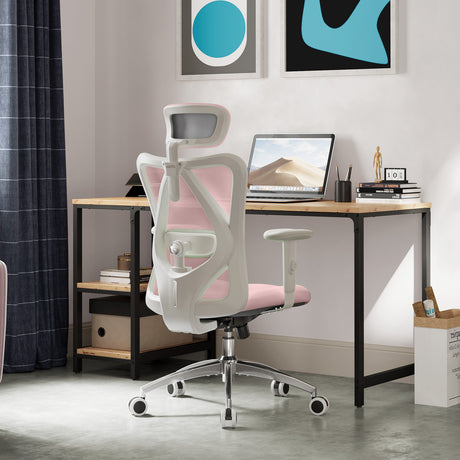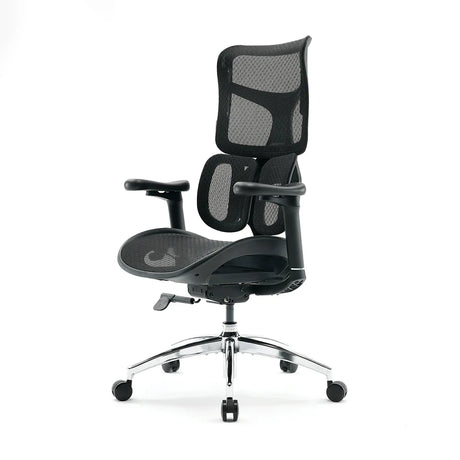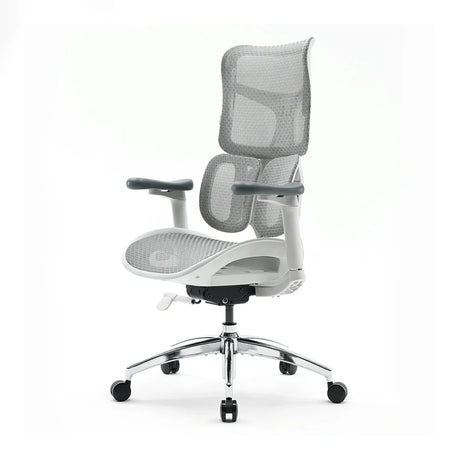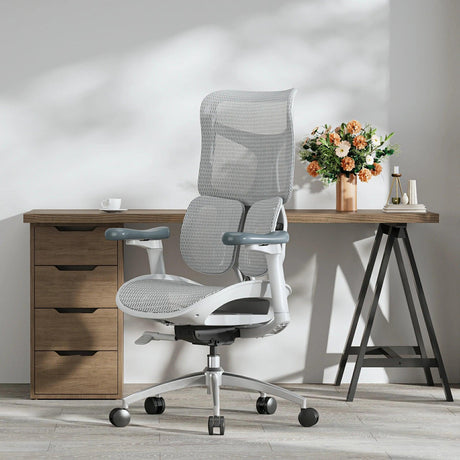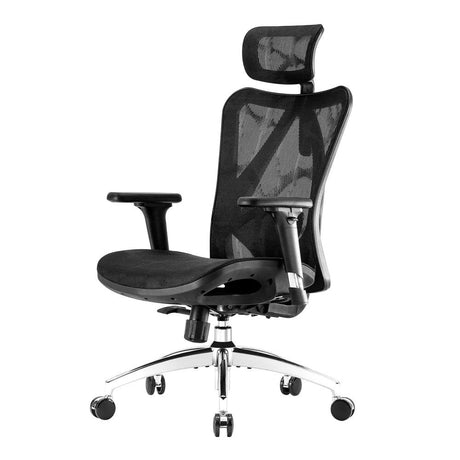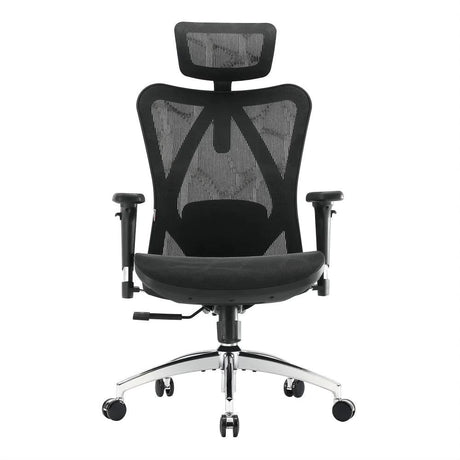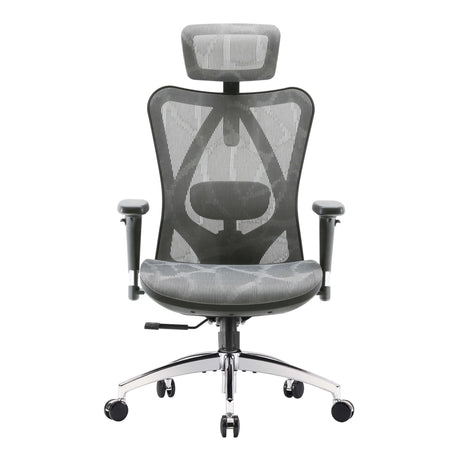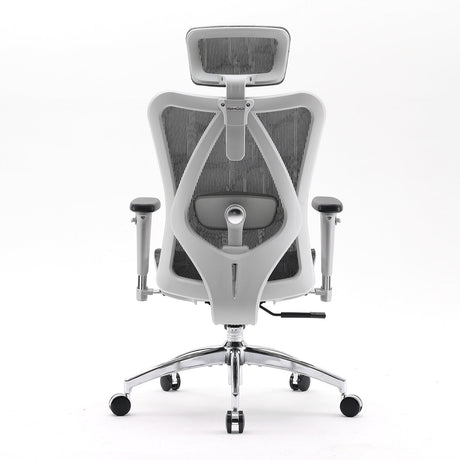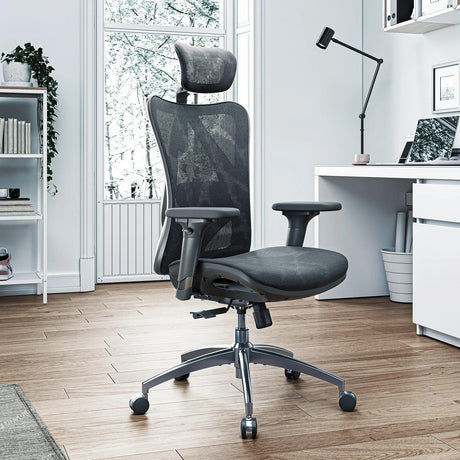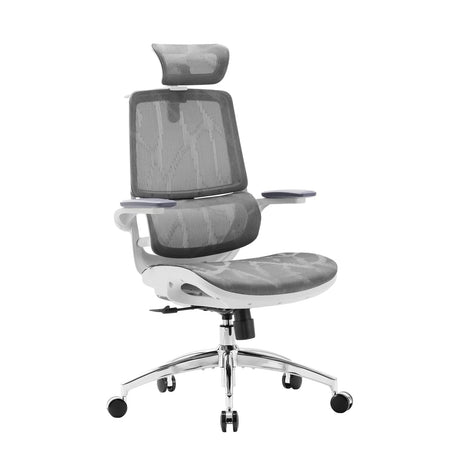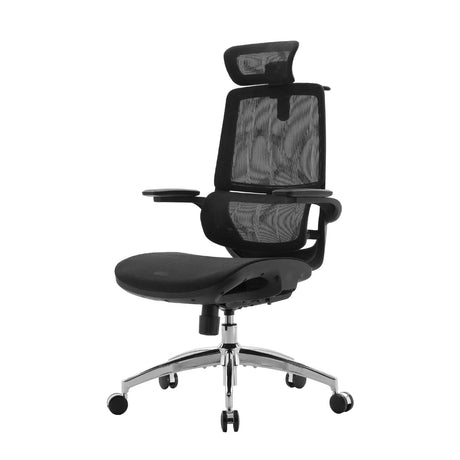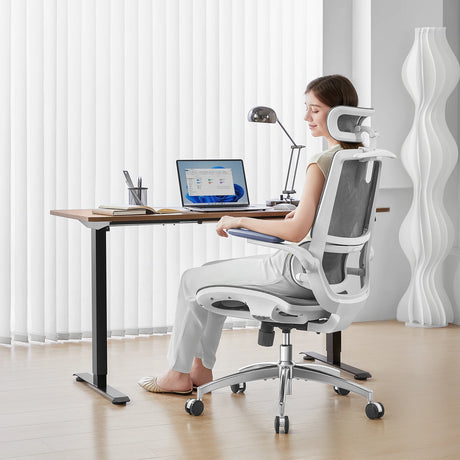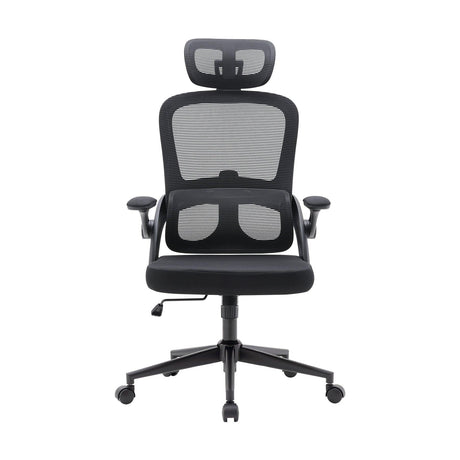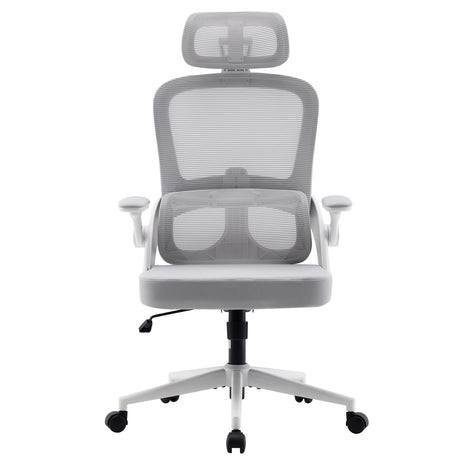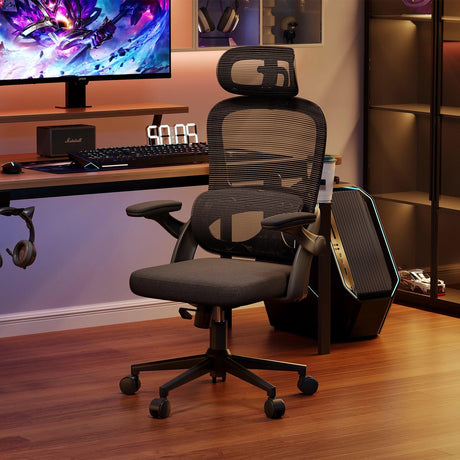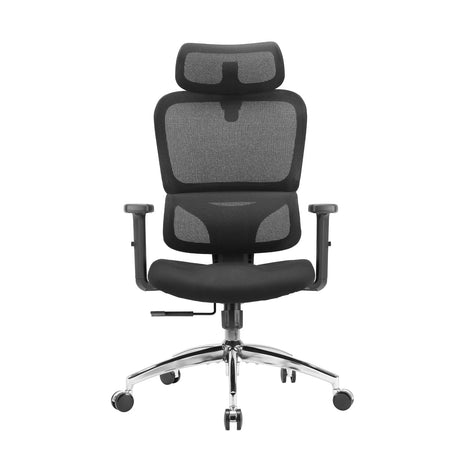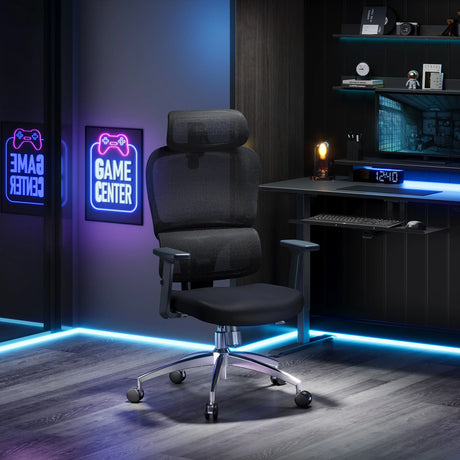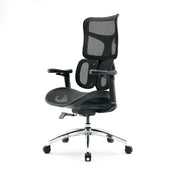Finding the right ergonomic chair can make or break your daily productivity and long-term comfort. Among the top contenders in Sihoo’s lineup, the Sihoo M57 and Sihoo M56B stand out as two of the most refined mid-range ergonomic chairs.
Both models are designed with Sihoo’s signature focus on ergonomic support, breathability, and durability, yet they cater to slightly different user preferences. The M57 is built for those who value maximum airflow, adaptive lumbar support, and recline versatility, while the M56B emphasizes dynamic lumbar adaptability, a saddle-shaped seat design, and user inclusivity across various body types.
In this in-depth comparison, we’ll break down every aspect — from build and comfort to ergonomics and long-term usability — to help you decide which Sihoo model best fits your work habits, posture, and personal comfort needs.
1. Design and Build Quality
Sihoo M57: Sleek and StreamlinedThe Sihoo M57 embodies a minimalist, modern aesthetic. Its full mesh construction gives it a clean, contemporary appearance that fits seamlessly into any office or home workspace. Beyond looks, that mesh design serves a functional purpose: it allows air to circulate freely through the backrest and seat, keeping you cool during long sitting hours.
Built with an aluminum alloy base and a steel gas lift, the M57 feels exceptionally stable and sturdy. The materials have been tested and certified by BIFMA and SGS, ensuring high safety and durability standards. It can comfortably support up to 330 lbs, making it suitable for a wide range of users who demand reliability and long-lasting performance.
The Sihoo M56B also offers a modern aesthetic but leans slightly more toward comfort-focused engineering than minimalism. Its frame combines reinforced steel and nylon materials for a robust yet lightweight structure, supporting up to 300 lbs. The breathable saddle-shaped mesh seat not only looks refined but is designed to distribute body weight evenly, reducing pressure points around the thighs and hips — an essential feature for users who sit for 8+ hours daily.
In comparison, the M57’s design prioritizes airflow and structural rigidity, while the M56B focuses more on ergonomic shaping and adaptive comfort. Both chairs score high on durability and build consistency, with materials that promise years of dependable use.
Verdict:
If you prefer a sleeker, full-mesh look with maximum ventilation and slightly higher weight capacity, the M57 takes the lead. For users who value balanced comfort and softer seat shaping, the M56B might feel more natural.
2. Comfort and Seating Experience
Sihoo M57: Breathable Mesh for All-Day CoolnessThe full mesh seat and backrest of the M57 are designed to keep users cool and supported in all climates. Unlike padded fabric or leather chairs, mesh resists heat buildup, which can be a game-changer for those working in warmer environments.
The contoured backrest maintains your spine’s natural “S” curve, while the dual-adjustable lumbar support — adjustable both vertically and horizontally — allows fine-tuning to your lower back’s curvature. Whether you’re sitting upright to focus or leaning back during a break, your lumbar area remains properly supported.
The recline range of up to 126° offers generous flexibility. Combined with its adjustable headrest (up to 3.9 inches vertically and 45° rotation), the M57 encourages healthy movement throughout the day while reducing fatigue in the neck and shoulders.
The M56B’s saddle-shaped mesh seat sets it apart. It slightly curves upward at the edges and dips in the center to promote better weight distribution, reducing pressure buildup under the thighs — a subtle but impactful ergonomic improvement.
Its 20.3-inch dynamic lumbar system dynamically flexes and adapts to your movements, providing active lower back support that adjusts with you as you shift positions. This feature is particularly useful for people who frequently lean forward or change postures throughout the day.
The smooth recline mechanism, with a locking feature that allows you to tilt up to 122°, gives a balanced combination of work-focused and relaxation modes. The recline tension is well-calibrated for controlled, natural movement.
Verdict:
The M57 delivers superior breathability and customizable recline angles, while the M56B’s adaptive lumbar and saddle-shaped seat make it more suitable for users seeking pressure relief and constant ergonomic feedback.
Sihoo M57 Office Chair
3. Ergonomic Features and Adjustability
Sihoo M57: Complete Ergonomic CustomizationThe M57 is engineered with comprehensive adjustability:
- 3D Adjustable Armrests: Move up/down, forward/back, and pivot to support different working postures — ideal for typing, writing, or phone use.
- Dual-Adjustable Lumbar Support: Lets you fine-tune both the height and depth to match your unique spinal curve.
- Adjustable Headrest: Offers both height and rotation adjustments, ensuring neck support whether sitting upright or reclining.
- Seat Height & Recline Control: Intuitive side handle allows quick seat height and tilt adjustment.
- Recline Up to 126°: Wide recline angle for relaxation during breaks.
Together, these features make the M57 suitable for users who want precise ergonomic control over their seating experience. It’s particularly great for professionals who switch between multiple desk tasks and recline frequently during the day.
Sihoo M56B: Thoughtful Adjustments for Everyday UseThe M56B focuses on essential ergonomics that improve comfort in real-world usage:
- 3D Adjustable Armrests: Soft PU pads provide cushion and reduce pressure on the elbows.
- 3D Headrest: Offers height and pivot adjustment to align with different body sizes (fits users from 5'0" to 6'3").
- Dynamic Lumbar Support: Automatically adapts to your posture, requiring less manual adjustment.
- Smooth Recline with Lock: Lets you relax safely at different angles without losing lumbar support.
Unlike the M57’s manual lumbar adjustment, the M56B’s dynamic lumbar system automatically conforms to your movements — a plus for users who prefer minimal manual tweaking.
Verdict:
If you enjoy having full control over your chair’s settings, the M57 is the better choice. But if you prefer an intuitive, adaptive experience that adjusts automatically, the M56B wins in ease of use.
4. Support and Ergonomic Science
Both chairs follow the ergonomic design philosophy of promoting spinal alignment, reducing pressure points, and encouraging healthy posture. Yet, their mechanisms differ in subtle but meaningful ways.
M57: Engineered for Postural PrecisionThe Sihoo M57’s contoured backrest and dual-adjustable lumbar provide direct, customizable support along the natural curvature of the spine. The structure of the backrest is designed to maintain the ideal “S” shape, which reduces strain on the lower vertebrae and shoulders.
The headrest and 3D armrests complement this posture-centric design, ensuring that every part of your upper body — from neck to wrists — remains in optimal alignment.
The M56B’s dynamic lumbar system goes a step further by offering movement-based adaptability. This system flexes with your back as you shift positions, offering consistent pressure relief without manual readjustment. It’s especially beneficial for users who lean forward often, such as designers, writers, and developers.
Additionally, the saddle-shaped mesh seat promotes open hip posture, reducing compression and maintaining blood flow to the legs — a key ergonomic feature for long sitting sessions.
Verdict:
The M57 offers precision-driven ergonomics with adjustable features for customization. The M56B provides motion-responsive ergonomics that automatically adapt to your needs. Your choice depends on whether you prefer to control your comfort or let your chair adapt to you.
5. Durability and Build Standards
Both chairs meet BIFMA and SGS certification standards, ensuring structural reliability and material safety. However, there are slight differences in design philosophy.
- M57 features a steel gas lift and aluminum alloy base, offering a higher 330 lbs capacity and long-term structural integrity.
- M56B uses a reinforced steel and nylon frame, providing up to 300 lbs capacity — slightly less but still robust for most users.
In daily use, both feel stable and creak-free, even when reclining or shifting weight. The M57, with its all-mesh build, is more resistant to sagging and heat over time, while the M56B’s slightly padded mesh seat offers a softer, more cushioned sitting experience.
Verdict:
If long-term durability and higher load capacity are priorities, the M57 edges ahead. But if you prefer slightly softer seating with a bit more give, the M56B delivers comfort without sacrificing strength.
6. Ease of Assembly and Maintenance
Both chairs are easy to assemble, with clearly labeled parts and tools included.
The M57’s all-mesh design makes cleaning effortless — a simple vacuum or damp cloth removes dust easily.
The M56B, with its combination of mesh and cushion, may require a bit more care but offers a more comfortable, upholstered feel.
Verdict:
Both models are user-friendly to set up and maintain, but the M57 is easier to keep spotless thanks to its fully mesh build.
7. Who Each Chair Is Best For
Sihoo M57 – Ideal For:- Users who prefer maximum airflow and cool comfort during long sessions
- Those who want precise lumbar adjustment and a deeper recline
- Professionals who value sleek, minimal design and strong build quality
- Users needing a higher weight capacity (up to 330 lbs)
- Users seeking automatic lumbar adaptability for frequent movement
- Those who prioritize pressure relief via the saddle-shaped mesh seat
- Individuals between 5’0” and 6’3” who want universal fit
- Professionals who prefer soft PU armrests and dynamic support over micro-adjustments
Sihoo M56B Office Chair
8. Price and Value
While pricing may vary by region or retailer, the M57 typically sits slightly above the M56B in cost due to its aluminum components and more complex lumbar adjustment system. However, both offer excellent value for their price segment compared to premium ergonomic chairs costing two or three times as much.
The M56B, with its adaptive lumbar and ergonomic seat shaping, delivers remarkable comfort at a competitive price — making it a compelling option for users who want professional-grade comfort without the premium price tag.
9. Certifications and Recognition
Both chairs hold BIFMA and SGS certifications, confirming they meet international standards for safety, stability, and durability.
The Sihoo M57 has been particularly recognized by top review platforms like Creativebloq, TechRadar, and ExpertReviews, earning praise as one of the best budget-friendly ergonomic chairs for its adjustability and cooling mesh design.
10. Final Verdict: Sihoo M57 vs Sihoo M56B
Feature |
Sihoo M57 |
Sihoo M56B |
Weight Capacity |
330 lbs |
300 lbs |
Lumbar Support |
Dual-adjustable |
Dynamic (auto-adaptive) |
Seat Design |
Full mesh |
Saddle-shaped mesh |
Headrest |
Adjustable height & rotation |
3D adjustable |
Armrests |
3D adjustable |
3D adjustable with wide PU pads |
Recline Angle |
126° |
122° |
User Height Range |
5'2"–6'2" |
5'0"–6'3" |
Airflow |
Excellent |
Very good |
Best For |
Users who want precision and full adjustability |
Users who prefer automatic lumbar comfort and seat softness |
In summary:
- Choose the Sihoo M57 if you want customizable ergonomics, superior airflow, and a robust build designed for all-day performance.
- Choose the Sihoo M56B if you prefer adaptive support, a pressure-relieving seat, and ergonomics that automatically follow your movement.
Either way, both models represent Sihoo’s commitment to delivering premium ergonomic comfort at accessible prices — making them two of the best options in the ergonomic chair market today.
FAQs
1. Which is better for back pain, Sihoo M57 or M56B?Both chairs provide excellent back support, but the M56B’s dynamic lumbar system offers continuous adaptive support that moves with your spine, which may be more beneficial for users with chronic lower back pain. The M57, with its dual-adjustable lumbar, suits those who prefer manually tuning their support.
2. Is the Sihoo M57 cooler to sit on?Yes. The full mesh design of the M57 maximizes airflow and prevents heat buildup, making it ideal for warm environments or long hours of use.
3. Which chair is more suitable for taller users?Both accommodate taller individuals, but the M56B supports a slightly wider height range (5’0” to 6’3”), making it more inclusive for both shorter and taller users.
4. Are both chairs easy to assemble?Yes. Both the M57 and M56B come with detailed instructions and tools, and can be assembled in under 20-25 minutes.
5. Which has a higher recline angle?The M57 reclines up to 126°, giving a slightly more relaxed lean compared to the M56B’s 122°.
6. Do both chairs meet international safety standards?Absolutely. Both are BIFMA and SGS certified, ensuring top-level safety, stability, and durability.
Conclusion
When comparing Sihoo M57 vs Sihoo M56B, it’s clear that each chair excels in its own way.
- The Sihoo M57 is the more advanced option for users who love adjustable ergonomics, refined aesthetics, and all-day coolness.
- The Sihoo M56B, on the other hand, brings adaptive comfort and inclusive design to the forefront, making it ideal for those who want simplicity and dynamic lumbar support.
Whichever you choose, both stand as shining examples of Sihoo’s mission: to make high-quality ergonomic comfort accessible to everyone.

